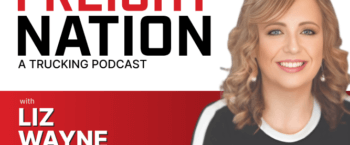Carrier Packets: A Simple Checklist for Brokers

Onboard with confidence
Take a deep dive into risk mitigation for freight brokers.
Brokers do more than hire carriers to move products for shippers. They oversee a highly regulated process that includes following strict rules and regulations set by the Department of Transportation (DOT), Internal Revenue System (IRS), National Highway Traffic Safety Administration (NHTSA), and the Federal Motor Carrier Safety Administration (FMCSA).
To avoid having paperwork take over the majority of your work time as a freight broker, there are ways to streamline creating, sending out, and processing carrier packets to stay compliant and keep your business on the road.
What is a carrier packet in trucking?
In some cases, a carrier packet might be called a broker packet. Brokers send a collection of documents and agreements for each new carrier or carrier network. This facilitates carrier setup to help get them approved to haul freight. The carrier completes all of the various contracts and documents and returns them to the broker.
All necessary documentation, contracts, and agreements in the packet must be completed in order to properly onboard carriers, communicate expectations, and ensure compliance with regulatory entities.
What’s included in a carrier packet?
Carrier packets are a place to capture both carrier and broker information, keep all details in a central and organized location and build strong working relationships.
Here are the documents you should include in your packet.
Broker-carrier agreement. The broker and carrier’s agreement includes information such as the carrier’s Motor Carrier (MC) number, the agreement date, the number of days until payment, invoicing procedures, insurance requirements, cargo limitations, contract dates, and pickup and delivery details.
Completed W-9 form. The IRS requires W-9 forms indicating the amount of income paid to the carrier.
Liability insurance. Depending on their classification, carriers must have various cargo insurance policies. The carrier must provide an insurance certificate showing that they have the minimum required amount of liability insurance. It’s the broker’s responsibility to confirm that the insurance certificates for their carriers are valid and up-to-date.
Copy of MC operating authority. Carriers who haul freight must have an MC number assigned by the FMCSA. The MC number indicates that the carrier has the legal right to provide transportation of property.
Safety rating documentation. Carriers must provide their motor carrier safety rating to brokers. Depending on their compliance history, drivers might have a rating of satisfactory, conditional, or unsatisfactory.
Broker bonds. Proof that the broker has a freight broker surety bond, as required by the state. Brokers must provide $75,000 collateral to secure the bond. Or, you can work with a surety broker to get a freight broker bond for 1.25% to 10% of the required bond amount. This annual premium is determined by the broker’s credit history, financial situation, and the number of years the brokerage has been in business.
Transportation licensing. Proof that the driver has the proper license required to operate the truck legally. Brokers may require that a carrier furnish a photograph of their state-issued license to prove that they have a commercial driver’s license (CDL) with the correct designation.
Invoicing procedures. How to initiate payments and where to send documents to receive payment after load delivery.
New carrier profile information. This is all identifying information about a new carrier that a broker requires for the onboarding process.
Details should include:
-
Carrier’s company name
-
Mailing address
-
MC number
-
DOT number
-
Federal ID number
-
Standard Carrier Alpha Code (SCAC) number
Carrier quick pay options. If offered by a broker, quick pay options provide expedited payment to approved carriers through factoring. Carriers might have to pay a 1% to 3.5% fee for access to quick pay options. Brokers should include details about how a carrier can expedite payment. For example, they may need to provide an invoice, bill of lading, load number, and supporting documents.
Why are broker-carrier packets important?
Having a complete carrier packet helps mitigate risk for the broker and the carrier partners. These packets not only help the broker ensure the carrier is qualified to haul the load, but they also outlines payment terms, responsibilities, who is liable in specific instances, cargo and delivery expectations, and other important requirements that protect both parties.
Ways carrier packets improve broker processes:
Streamline onboarding
Onboarding new carriers is very time-consuming for brokers. Carrier onboarding software can help alleviate the burden by automating much of the process while verifying accuracy to greatly reduce the time it takes to onboard a new carrier.
Mitigate risk
When onboarding new carriers, brokers often have concerns about fraudulent carrier documents and identity theft. When you take time to carefully comb through a carrier’s documentation and verify that everything is accurate and up-to-date, you reduce your chances of hiring a less-than-honest carrier.
The challenge with traditional carrier packets
Brokers work with multiple carriers to move freight safely while sticking to important deadlines. Paperwork creates a huge burden for brokers as they struggle to manually track carrier documentation, onboard new carriers, and keep up with critical carrier compliance monitoring.
Vetting new carriers before you hire them involves checking their safety rating and accountability scores and confirming that their insurance and liability coverage meets the minimum standard.
Lapses with a carrier’s insurance coverage, safety rating changes, and expired operating authorities can make a broker’s day-to-day life difficult. Struggling to keep up with the paperwork can present significant challenges to brokers as they work to develop a thriving business.
Fortunately, brokers can access advanced software specially designed to help lighten the paperwork load and automate processes when it comes to carrier onboarding and carrier monitoring.

Automate carrier onboarding and compliance monitoring.
Automated onboarding and monitoring tools save you time, reduce costs, and build trust with shippers.
Compliance solution, like RMIS Carrier Onboarding helps brokers automate the onboarding process and ensure ongoing compliance monitoring while alleviating the paperwork burden of traditional methods. It also enables brokers to onboard carriers up to 80% faster than traditional manual vetting methods.
With the help of software automation, brokers can set carrier selection rules to help find high-quality carriers fast, access TIA Watchdog reports, and continuously monitor carrier compliance to avoid lapses in coverages or change in authority to better protect their business against carrier-caused risk.
Your approach to onboarding and compliance is also important to shippers because it assures them they can trust you are protecting their product and their business.
Protect your business
You are one of the first lines of defense when it comes to protecting your business. Knowing what to expect, from whom, and when will help you quickly weed out the good from the bad.
Truckstop RMIS Carrier Onboarding helps you quickly and accurately qualify carriers, minimizing your risk of fraudulent activity without the hassle of extra paperwork. Get daily status updates, change notifications, and carrier directory sourcing tools to save you time and protect your business.

Find out how our platform gives you the visibility you need to get more done.
Get helpful content delivered to your inbox.
Schedule a demo.
Find out how our platform gives you the visibility you need to get more done.





